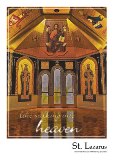St. Lazarus's Church (Paynterton)
| St. Lazarus's Church VSB |
| St. Lazarus's Church
Paynterton [93,38]
Basic Info:
|
Description
St Lazarus's Church is used as an entry point for the adjacent NT buildings (the Gracewood Building, the Packe Building) and The Casely Building, as well as being a safehouse for survivors without the Free Running skill.
The Greek Orthodox Church is a small concrete building, some of its windows are missing and the rest are broken.
The interior is divided into three areas: the narthex, the nave, and the sanctuary. The narthex is the entrance area, where the faithful make an offering, receive a candle, light it before an icon, and offer a personal prayer before joining the congregation. The nave is the large center area of the church. On the right-hand side of the nave is the bishop's throne. On the left-hand side of the nave is the pulpit from which the Gospel is proclaimed and the sermon preached. The choir and the cantors frequently occupy areas on the far sides of the nave. The sanctuary is considered the most sacred part of the church, and the area reserved for the clergy and their assistant. The sanctuary contains the Holy Altar and is separated from the nave by the Iconostasion, a panel of icons which separates the sanctuary from the nave. The Iconostasion has three entrances which are used during services. There is a Deacon Door on either side, and the center entrance which is called the Royal Door. A curtain or door, usually conceals the Altar when services are not being celebrated. On the right-hand side of the Iconostasion are the icons of Christ and St. John the Baptist. On the left-hand side are always the icons of the Theotokos (Mother of our Lord) and St Lazarus.
The Altar or Holy Table is square in shape, and stands away from the wall. When the Church is repaired the altar is often covered with cloths. A tabernacle, is set upon the Altar, together with candles. The Book of Gospels rests on the Altar. Behind the Altar is a large cross with the painted figure of Christ.
History
St Lazarus's Chapel, a Greek Orthodox chapel, was first built in 1573 by Greek Cypriots, descended from those who had fled Cyprus following the Ottoman invasion in 1570. When the Chapel fell into disrepair during the Great Depression it was demolished, and replaced by the current church in 1934.
According to the bible, (John 11) St Lazarus died and was raised from the dead by Jesus. St Lazarus went on to become a bishop in Cyprus. Lazarus's second tomb is on Cyprus at the Greek Orthodox church of Agios Lazaros in Larnaka. In 890 A.D. his tomb was discovered bearing the inscription "Lazarus the friend of Christ". The marble sarcophagus can be seen inside the church under the Holy of Holies. His relics were taken from Cyprus to Constantinople in 898. The relics were stolen from Constantinople by the Crusaders and transferred to Marseilles, France in 1204 as part of the booty of war from the Fourth Crusade, at which point they disappeared. In 1972 human remains were discovered under the altar during renovation works in the church at Larnaka, and were identified with part of the saint's relics, the remaining relics locations are not known.
Legend has it that some of the relics were transferred from France to the Church dedicated to the saint, and that they had the power to bring people back from the dead. Every year on the day before Palm Sunday, St Lazarus Saturday, was celebrated here. Rumours abounded that newly dead people placed in the Church on the Saturday would be resurrected.
Necro-Tech became aware aware of these rumours during the 1980s, and built The Lazarus Complex around the church. The Packe Building, the Gracewood Building and the Casely Building were built around the church and it’s cemetery. An additional long-arm Necrotech facility was built nearby, the Pender Building.
Barricade Policy
Very Strongly Barricaded per Paynterton Barricade Plan.
Current Status
| This page, St. Lazarus's Church (Paynterton), is a locations stub. Please help us to improve the wiki by contributing to this page. Be sure the following information is added to the page: coordinates, suburb, 9 block map (or 16 block map for large buildings), description, barricading policy, and history. Please refer to the Location Style Guide. |

